Experimental and Numerical Investigation of Rotor–Stator Interaction in a Large Prototype Pump–Turbine in Turbine Mode
Abstract
:1. Introduction
2. Field Measurement
3. Numerical Calculations
3.1. Numerical Method of Three-Dimensional Fluid Dynamics Calculation
3.2. Mechanism Analysis of RSI Phenomenon
4. Fluid Numerical Calculations
4.1. Models, Meshes, and Calculation Settings
4.2. Velocity and Pressure Distributions at Vaneless Space
4.3. RSI-Induced Pressure Fluctuations Analysis
4.3.1. Layout of Pressure Monitoring Points for Numerical Calculations
4.3.2. Pressure Fluctuations Comparison between Calculation and Measurement
- –
- The simplification of the 3D models of the fluid domains, such as small chamfers, can also lead to a small error in simulations.
- –
- The rated head of the pump–turbine unit is used for all numerical calculations, but during the field tests, the water levels of the upper and lower reservoirs of the PSPS under operation varied over time, resulting in slight variations in the head that did not always match the design rated head exactly.
- –
- Errors can also occur from the site measurement due to differences in sensor arrangement and human factors of the surveyor.
4.3.3. Pressure Fluctuations along the Guide Vane Passage
4.3.4. Pressure Fluctuations along with the Vertical Height
4.3.5. Pressure Fluctuations along the Circumferential Direction
4.3.6. Pressure Fluctuations along Runner Passage Flow Direction
5. Conclusions
- 1.
- The three-dimensional models of a prototype pump–turbine including clearances were built. The mesh independence analysis was conducted to eliminate the influence of numerical models on the calculation results. The calculated and measured operating parameters were compared, and the good agreement verified the reliability of the numerical calculation.
- 2.
- The unsteady calculations of 60% load, 86.7% load, and 100% load conditions were performed to obtain the evolution law of pressure fluctuations in the vaneless space.
- 3.
- Along the flow direction of the guide vane passage, 7 times and 14 times the rotational frequency of the pressure fluctuations in the vaneless space are disturbed by the rotation of the runner, and the corresponding peak values tend to increase from upstream to downstream. The pressure fluctuations of 21 times the frequency are formed by the interference between the runner rotation and the wake of the guide vane, so the amplitudes of 21 of the monitoring points are related to the distances to the runner blade leading edge and to the guide vane trailing edge.
- 4.
- The pressure fluctuations along the vertical height direction in the vaneless space show high consistency at 86.7% load and 100% load conditions. At the low-load condition of 60% load, the low-frequency pressure waves caused by the intensive draft tube vortex propagate to the vaneless space and result in inconsistent pressure fluctuations in the vertical direction.
- 5.
- The amplitudes of different frequency components of pressure fluctuations in the vaneless space along the circumferential direction show a different pattern. For the pressure fluctuations of 7 and 14, the amplitudes are more evenly distributed along the circumferential direction. However, non-uniform pressure fluctuations of 21 in the circumferential direction are caused by the circumferential asymmetry of the spiral case and the stay ring.
- 6.
- Different frequency components of pressure fluctuations along the runner channel can be observed. The dominant pressure fluctuation frequency induced by the RSI acting on the runner is 20. The amplitudes of 20 at the low-load condition of 60% load are higher than those of 86.7% load and 100% load, and the amplitudes of 20 decrease along the runner flow channel from upstream to downstream. At 60% load, the low-frequency pressure waves generated by the draft tube vortex also propagate upstream and affect the pressure fluctuations in the runner blade passages.
- 7.
- It is recommended to design the runner with inclined inlets to reduce the amplitudes of RSI-induced pressure fluctuations and to avoid operating the pump–turbine units under partial load for long periods of time to reduce the risk of pressure-fluctuation-induced severe vibration on the structures.
Author Contributions
Funding
Institutional Review Board Statement
Informed Consent Statement
Data Availability Statement
Acknowledgments
Conflicts of Interest
Abbreviations
| CFD | Computational fluid dynamics |
| PSPS | Pumped-storage power station |
| RANS | Reynolds-averaged Navier–Stokes |
| PIV | Particle image velocimetry |
| PT | Pump–turbine |
| RSI | Rotor–stator interaction |
| SST | Shear stress transport |
References
- Frunzăverdel, D.; Muntean, S.; Mărginean, G.; Câmpiani, V.; Marşavina, L.; Terzi, R.; Şerban, V. Failure analysis of a Francis turbine runner. IOP Conf. Ser. Earth Environ. Sci. 2010, 12, 012115. [Google Scholar] [CrossRef]
- Egusquiza, E.; Valero, C.; Huang, X.; Jou, E.; Guardo-Zabaleta, A.; Rodriguez, C. Failure investigation of a large pump–turbine runner. Eng. Fail. Anal. 2012, 23, 27–34. [Google Scholar] [CrossRef] [Green Version]
- Guillaume, R.; Deniau, J.L.; Scolaro, D.; Colombet, C. Influence of rotor-stator interaction on the dynamic stresses of Francis runners. In Proceedings of the 26th IAHR Symposium on Hydraulic Machinery and Systems, Beijing, China, 19–23 August 2012; Volume 15, p. 052011. [Google Scholar] [CrossRef]
- Flores-Domínguez, M.; Urquiza, G.; Rodríguez, J. A Fatigue Analysis of a Hydraulic Francis Turbine Runner. World J. Mech. 2012, 2, 28–34. [Google Scholar] [CrossRef] [Green Version]
- Dorji, U.; Ghomashchi, R. Hydro turbine failure mechanisms: An overview. Eng. Fail. Anal. 2014, 44, 136–147. [Google Scholar] [CrossRef]
- Huang, X.; Chamberland-Lauzon, J.; Oram, C.; Klopfer, A.; Ruchonnet, N. Fatigue analyses of the prototype Francis runners based on site measurements and simulations. IOP Conf. Ser. Earth Environ. Sci. 2014, 22, 012014. [Google Scholar] [CrossRef] [Green Version]
- Egusquiza, E.; Valero, C.; Presas, A.; Huang, X.; Guardo, A.; Seidel, U. Analysis of the dynamic response of pump-turbine impellers. Influence of the rotor. Mech. Syst. Signal Process. 2015, 68, 330–341. [Google Scholar] [CrossRef]
- Lyutov, A.; Kryukov, A.; Cherny, S.; Chirkov, D.; Salienko, A.; Skorospelov, V.; Turuk, P. Modelling of a Francis Turbine Runner Fatigue Failure Process Caused by Fluid-Structure Interaction. IOP Conf. Ser. Earth Environ. Sci. 2016, 49, 072012. [Google Scholar] [CrossRef] [Green Version]
- Luna-Ramírez, A.; Campos-Amezcua, A.; Dorantes-Gómez, O.; Mazur-Czerwie, Z.; Muñoz-Quezada, R. Failure analysis of runner blades in a Francis hydraulic turbine—Case study. Eng. Fail. Anal. 2016, 59, 314–325. [Google Scholar] [CrossRef]
- Ghomashchi, R. Justification of the hydraulic turbines lifetime from the standpoint of the fracture mechanics. Procedia Struct. Integr. 2018, 13, 971–975. [Google Scholar] [CrossRef]
- Salary, A.; Verlinski, S.; Levonyan, H.; Tyagunov, A.; Tarasov, D. Fluid structure interaction analysis on failure of Francis turbine runner blades. Arpn J. Eng. Appl. Sci. 2018, 13, 1906–1911. [Google Scholar]
- Nicolet, C.; Ruchonnet, N.; Avellan, F. One-Dimensional Modeling of Rotor Stator Interaction in Francis pump–turbine. In Proceedings of the 11th International Symposium on Transport Phenomena and Dynamics of Rotating Machinery, ISROMAC-11.2, Honolulu, HI, USA, 6 February–2 March 2006. [Google Scholar]
- Nicolet, C.; Ruchonnet, N.; Alligne, S.; Koutnik, J.; Avellan, F. Hydroacoustic Simulation of Rotor-Stator Interaction in Resonance Conditions in Francis Pump-Turbine. In Proceedings of the 25th IAHR Symposium on Hydraulic Machinery and Systems, Timişoara, Romania, 20–24 September 2010; Volume 12. [Google Scholar] [CrossRef]
- Minakov, A.V.; Platonov, D.V.; Dekterev, A.A.; Sentyabov, A.V.; Zakharov, A.V. The numerical simulation of low frequency pressure pulsations in the high-head Francis turbine. Comput. Fluids 2015, 111, 197–205. [Google Scholar] [CrossRef]
- Franke, G.; Fischer, R.; Powell, C.; Seidel, U.; Koutnik, J. On pressure mode shapes arising from rotor/stator interactions. Sound Vib. 2005, 39, 14–18. [Google Scholar]
- Dan, C.G.; Jean-Louis, K. Experimental Analysis of the rotor–stator Interaction in a pump–turbine. In Proceedings of the 23rd IAHR Symposium on Hydraulic Machinery and Systems, Yokohama, Japan, 17–21 October 2006. [Google Scholar]
- Zobeiri, A.; Kueny, J.; Farhat, M.; Avellan, F. Pump-Turbine Rotor-Stator Interaction in Generating Mode: Pressure Fluctuation in Distributor Channel. In Proceedings of the 23rd IAHR Symposium on Hydraulic Machinery and Systems, Yokohama, Japan, 17–21 October 2006. [Google Scholar]
- Li, D.Y.; Gong, R.Z.; Wang, H.J.; Wei, X.Z.; Liu, Z.S.; Qin, D.Q. Analysis of Rotor–Stator Interaction in Turbine Mode of a Pump–Turbine Model. J. Appl. Fluid Mech. 2016, 9, 2559–2568. [Google Scholar] [CrossRef]
- Hasmatuchi, V.; Farhat, M.; Roth, S.; Botero, F.; Avellan, F. Hydrodynamics of a Pump-Turbine Operating at Off-Design Conditions in Generating Mode: Experimental Investigation. In Proceedings of the Conference: SHF Conference on Cavitation & Hydraulic Machines, EPFL, Lausanne, Switzerland, 26–27 May 2011. [Google Scholar]
- Liu, B.; Wang, H.; Liu, H.; Yu, H.; Jiang, H.; Chen, M. Experimental Investigation of Unsteady Flow Field in the Tip Region of an Axial Compressor Rotor Passage at Near Stall Condition With Stereoscopic Particle Image Velocimetry. J. Turbomach. 2004, 126, 360–374. [Google Scholar] [CrossRef]
- Chow, Y.; Uzol, O.; Katz, J. Flow Nonuniformities and Turbulent “Hot Spots” Due to Wake-Blade and Wake-Wake Interactions in a Multi-Stage Turbomachine. J. Turbomach. 2002, 124, 553–563. [Google Scholar] [CrossRef]
- Hasmatuchi, V.; Roth, S.; Botero, F.; Avellan, F.; Farhat, M. High-speed flow visualization in a pump-turbine under off-design operating conditions. IOP Conf. Ser. Earth Environ. Sci. 2010, 12, 012059. [Google Scholar] [CrossRef]
- Presas, A.; Luo, Y.; Wang, Z.; Guo, B. Fatigue life estimation of Francis turbines based on experimental strain measurements: Review of the actual data and future trends. Renew. Sustain. Energy Rev. 2019, 102, 96–110. [Google Scholar] [CrossRef]
- Huang, X.; Oram, C.; Sick, M. Static and dynamic stress analyses of the prototype high head Francis runner based on site measurement. IOP Conf. Ser. Earth Environ. Sci. 2014, 22, 032052. [Google Scholar] [CrossRef] [Green Version]
- Rodriguez, C.; Mateos-Prieto, B.; Egusquiza, E. Monitoring of Rotor-Stator Interaction in Pump-Turbine Using Vibrations Measured with On-Board Sensors Rotating with Shaft. Shock Vib. 2014, 2014, 276796. [Google Scholar] [CrossRef] [Green Version]
- Agnalt, E.; Iliev, I.; Solemslie, B.W.; Dahlhaug, O.G. On the Rotor Stator Interaction Effects of Low Specific Speed Francis Turbines. Int. J. Rotating Mach. 2019, 2019, 5375149. [Google Scholar] [CrossRef]
- Zuo, Z.; Liu, S.; Sun, Y.; Wu, Y. Pressure fluctuations in the vaneless space of High-head pump-turbines—A review. Renew. Sustain. Energy Rev. 2015, 41, 965–974. [Google Scholar] [CrossRef]
- Hu, J.; Yang, J.; Zeng, W.; Yang, J. Effect of the Speed Factor On the Amplitude of the Blade Passing Frequency in the Vaneless Space of a Pump Turbine in Turbine Mode. J. Fluids Eng. 2021, 143, 111203. [Google Scholar] [CrossRef]
- Tanaka, H. Vibration Behavior and Dynamic Stress of Runners of Very High Head Reversible Pump-turbines. Int. J. Fluid Mach. Syst. 2011, 4, 289–306. [Google Scholar] [CrossRef]
- Lais, S.; Liang, Q.; Henggeler, U.; Weiss, T.; Escaler, X.; Egusquiza, E. Dynamic Analysis of Francis Runners—Experiment and Numerical Simulation. Int. J. Fluid Mach. Syst. 2009, 2, 303–314. [Google Scholar] [CrossRef] [Green Version]
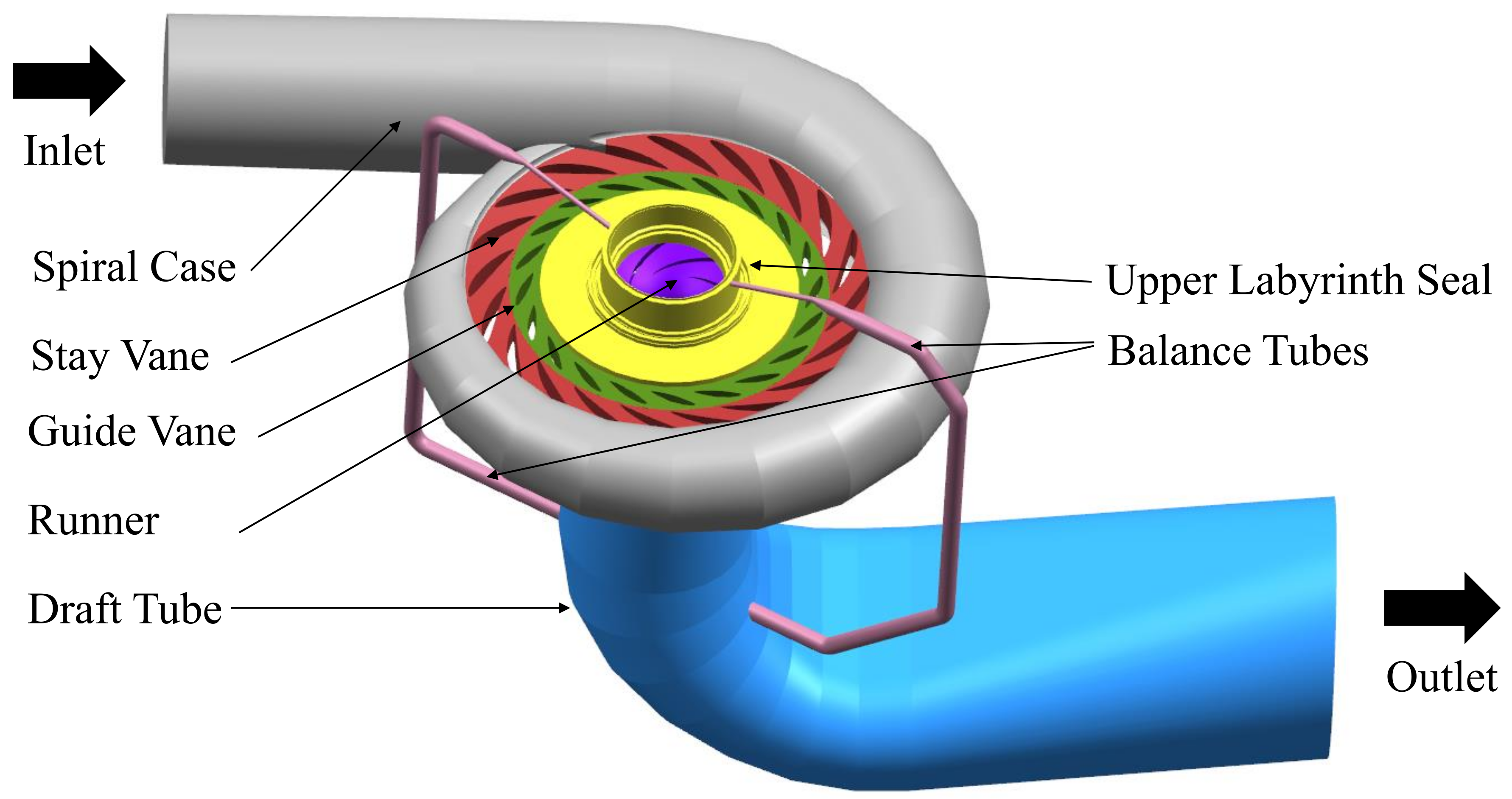
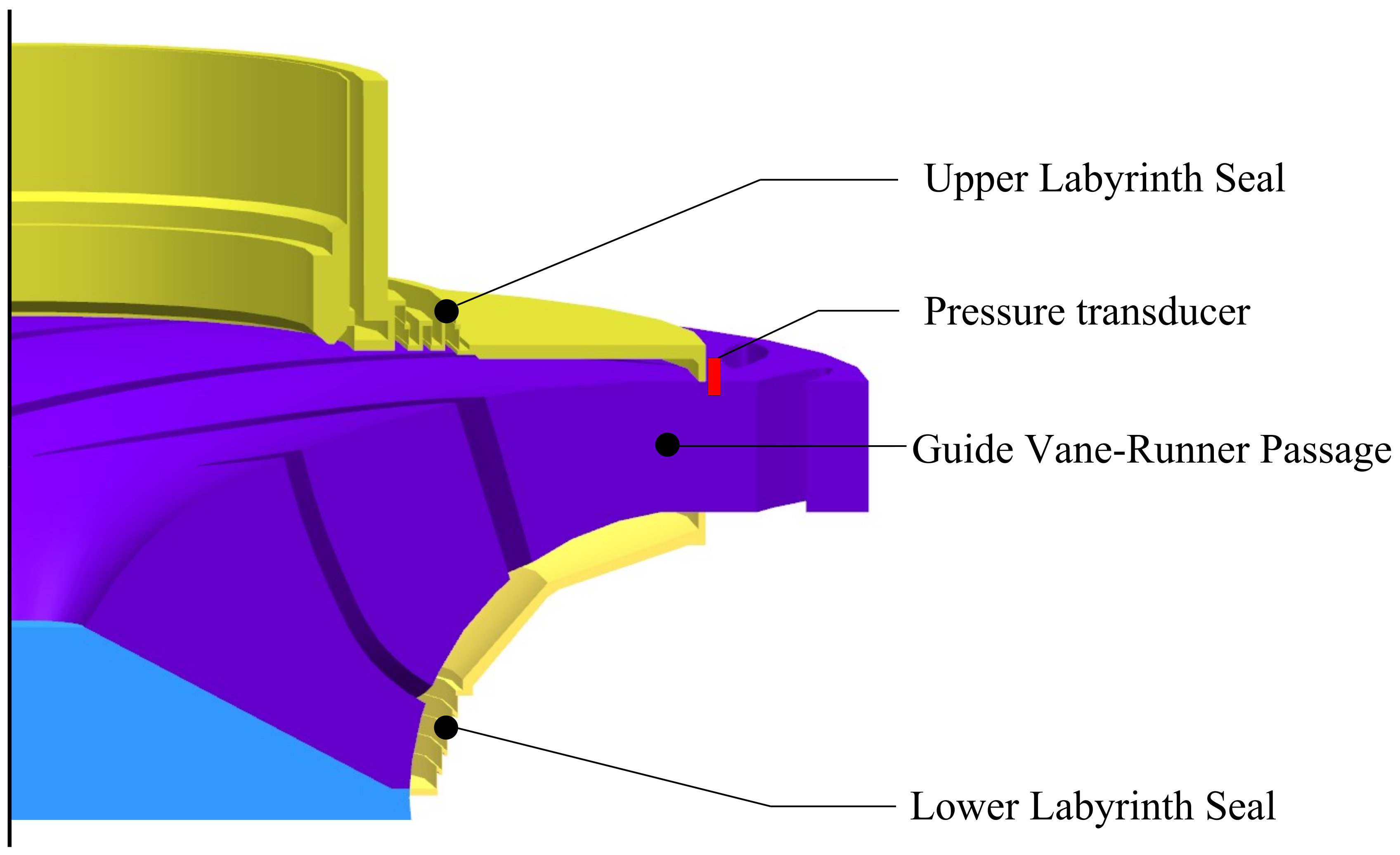
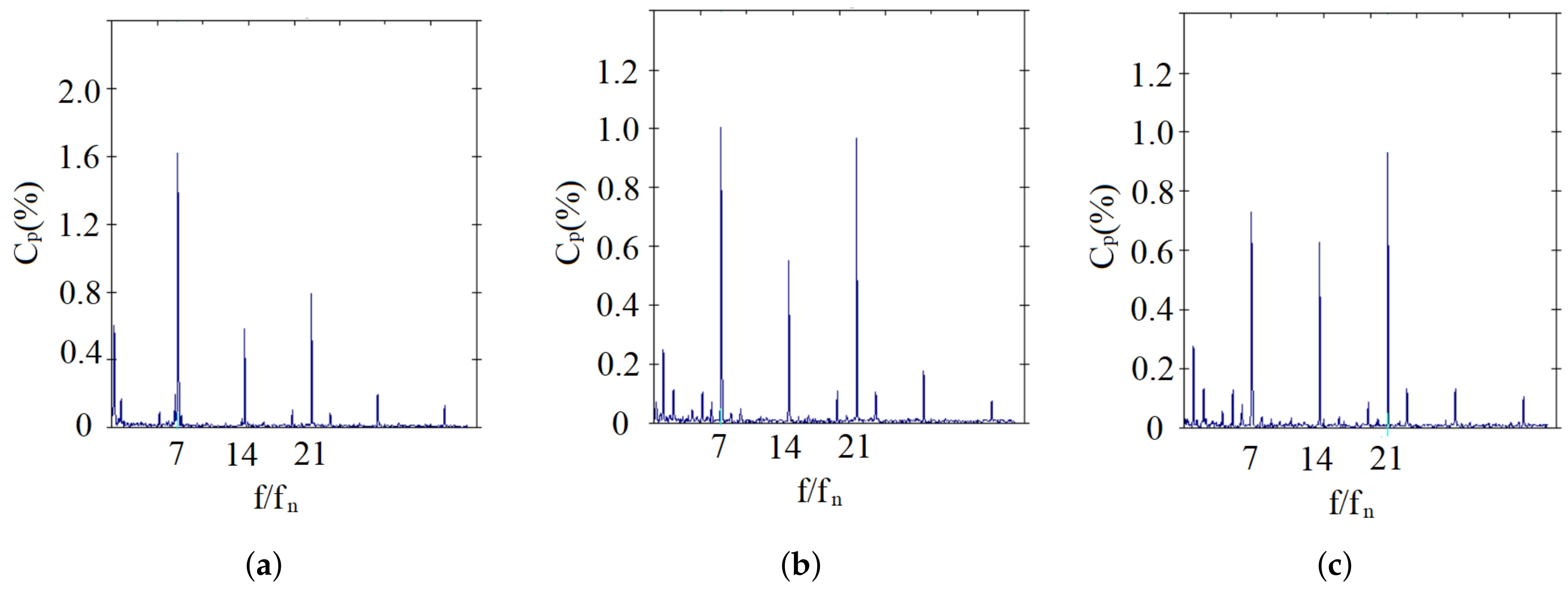
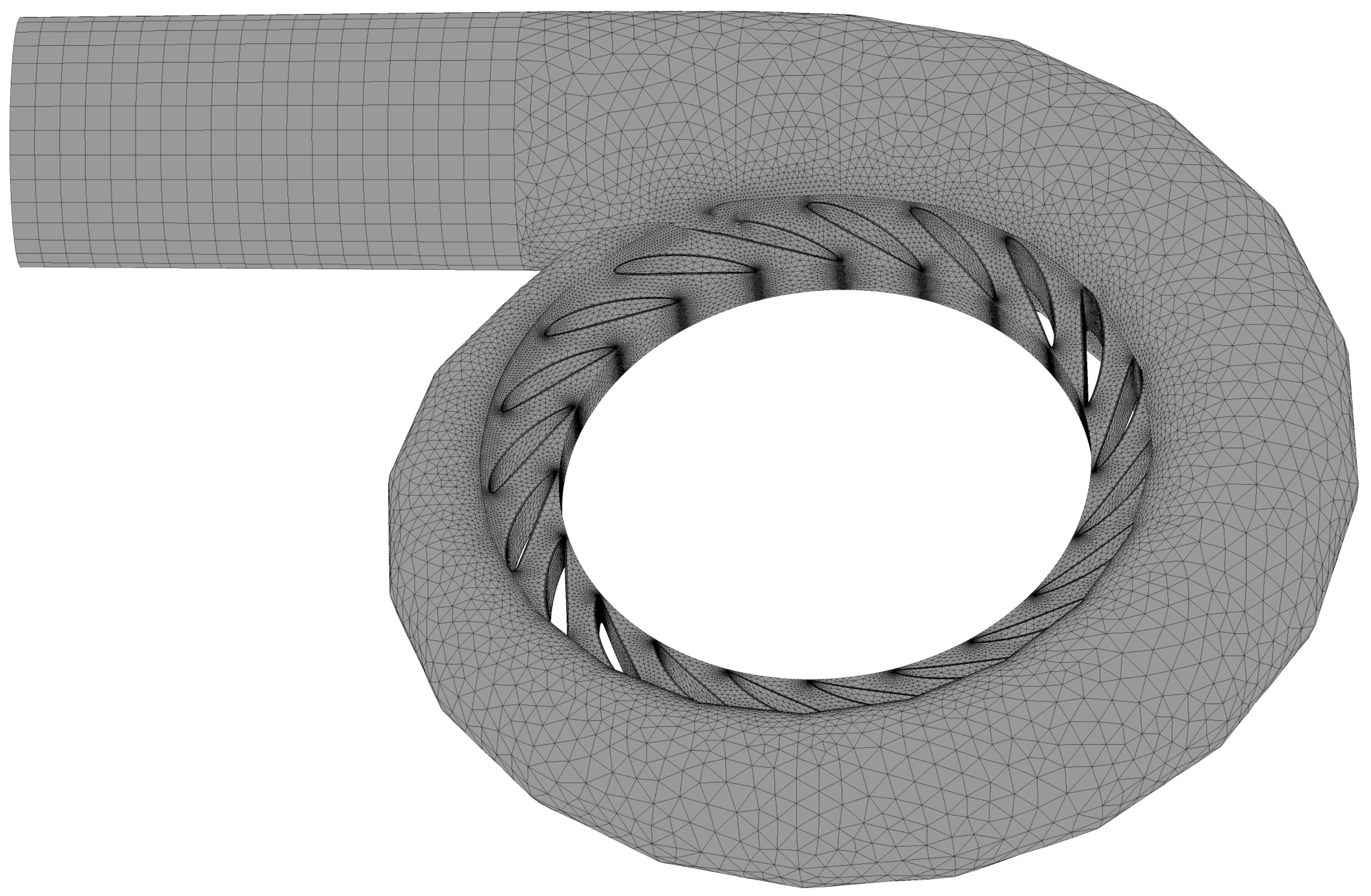

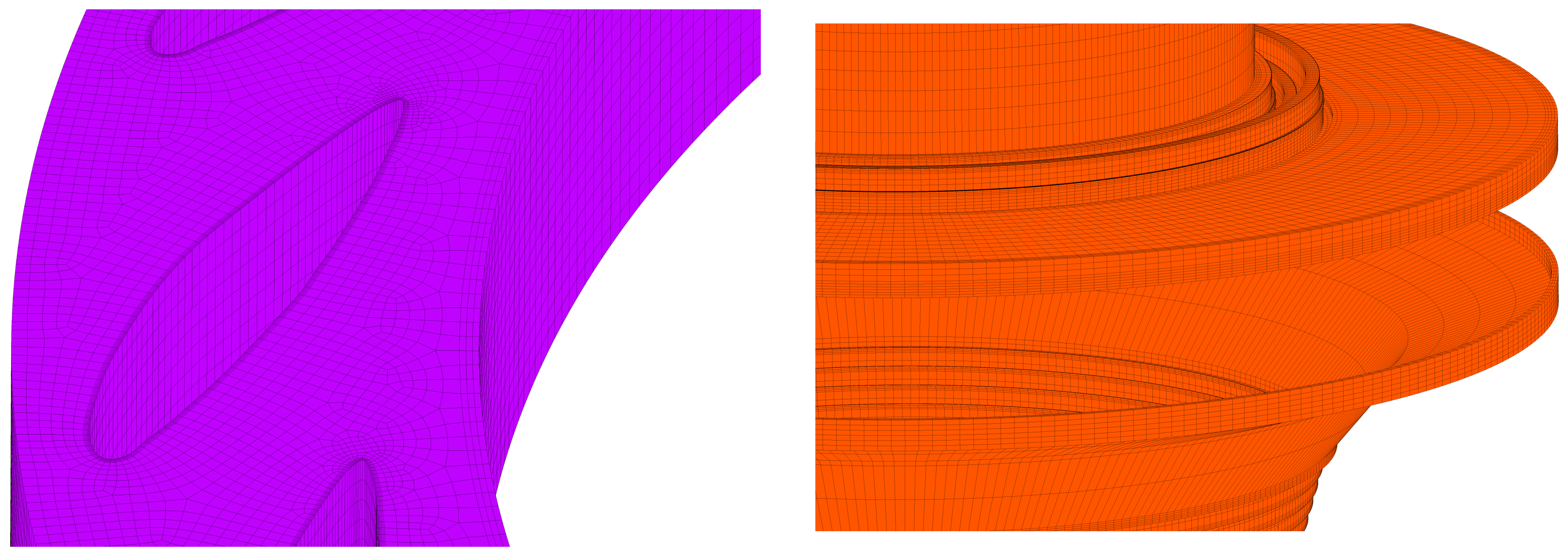
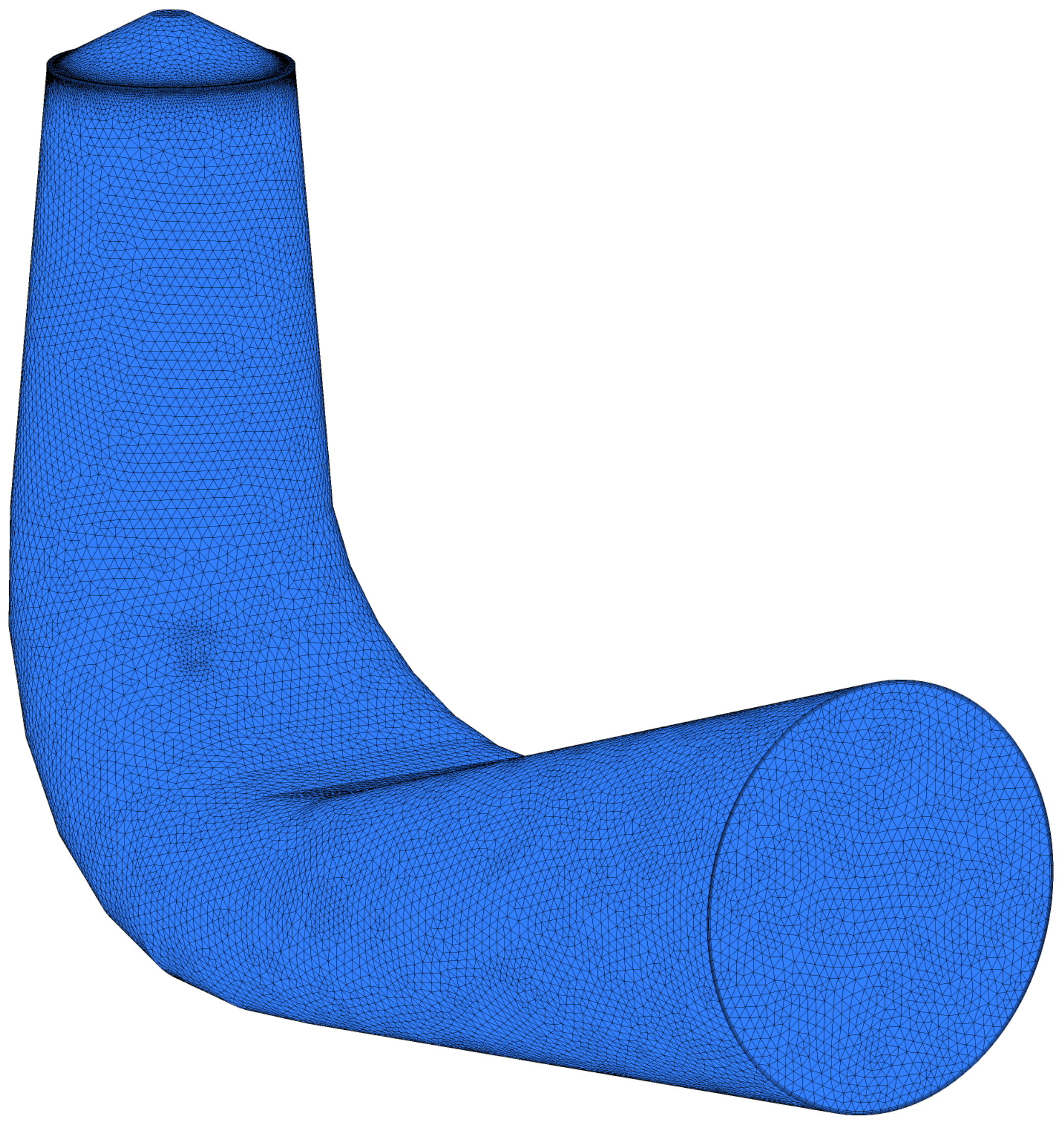
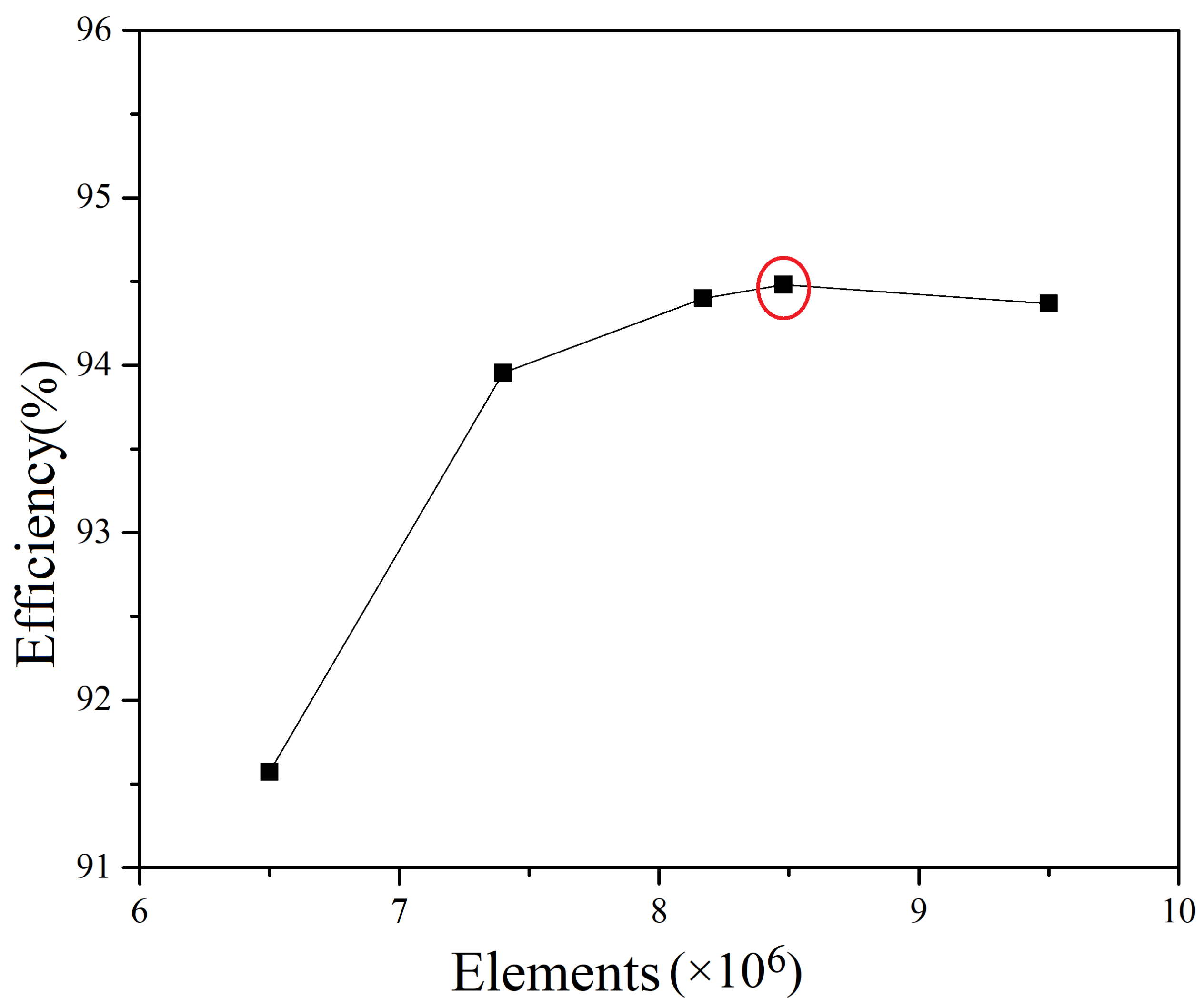


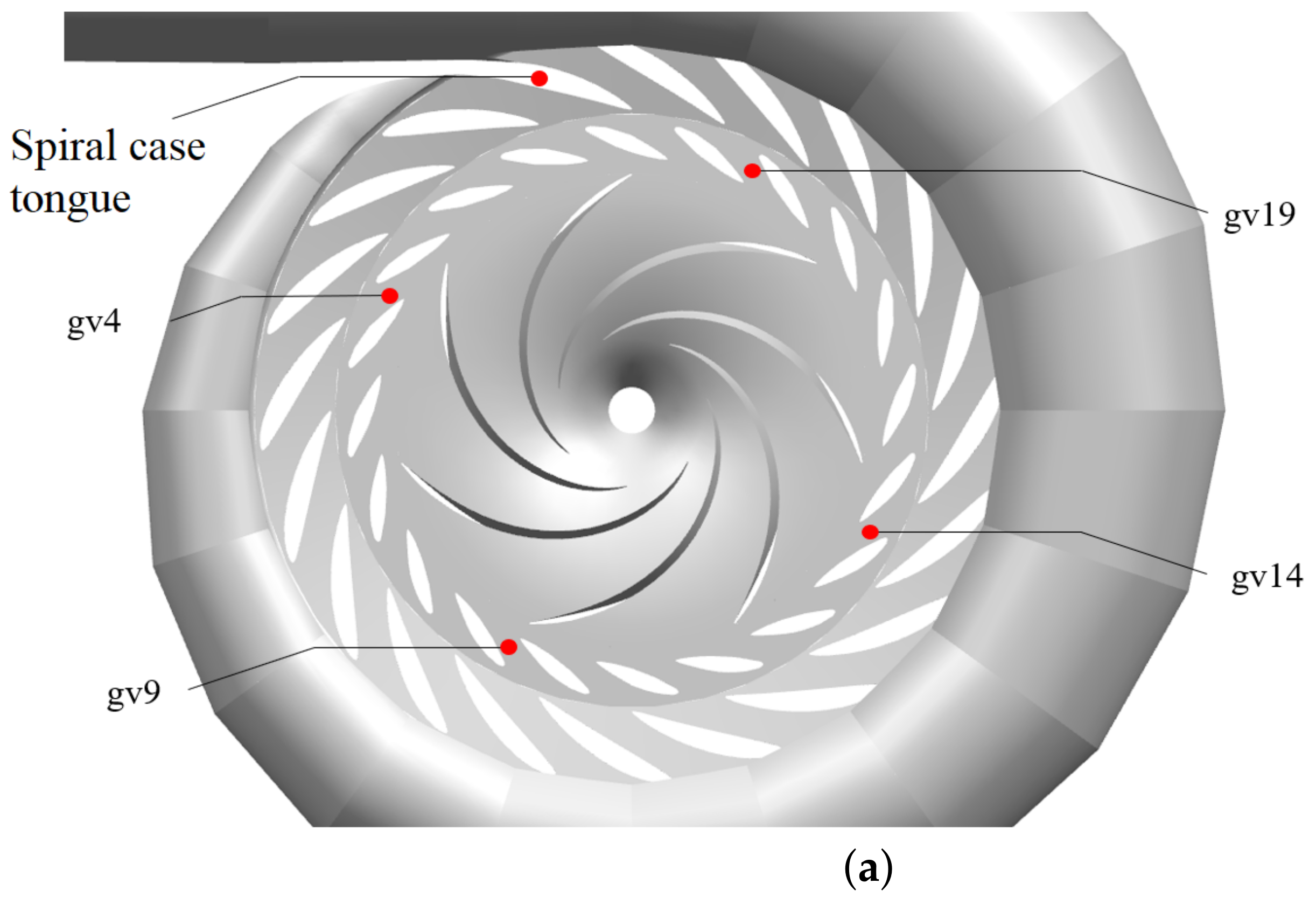
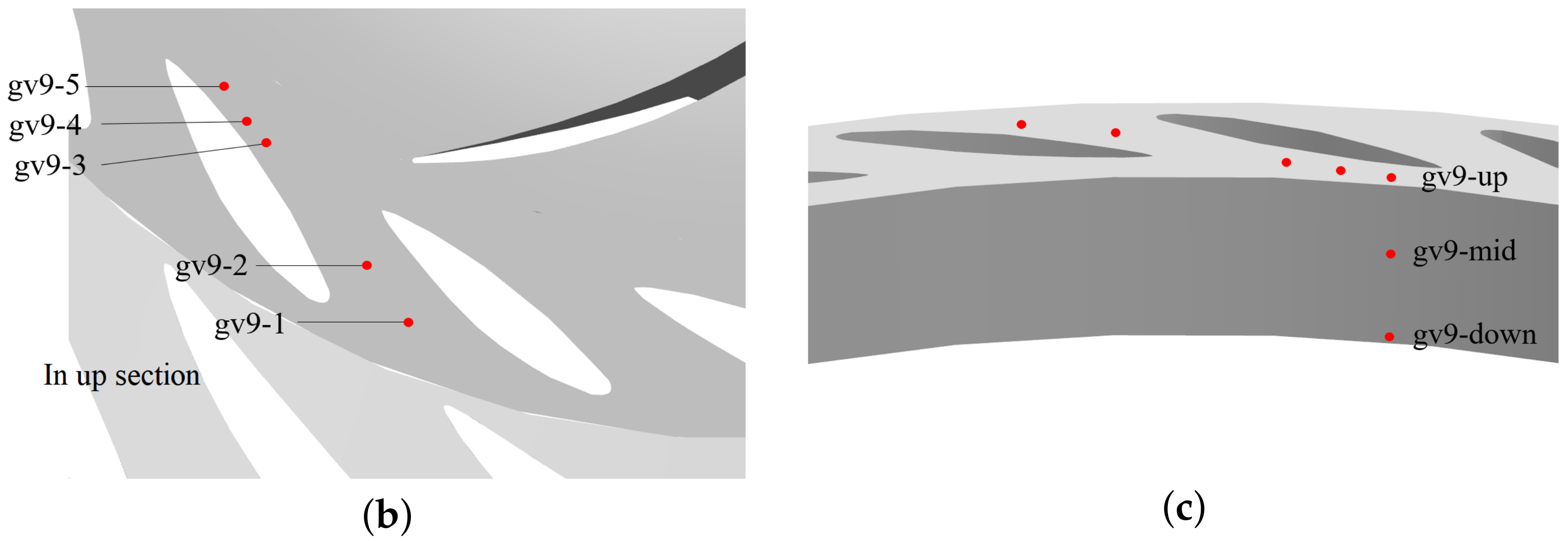
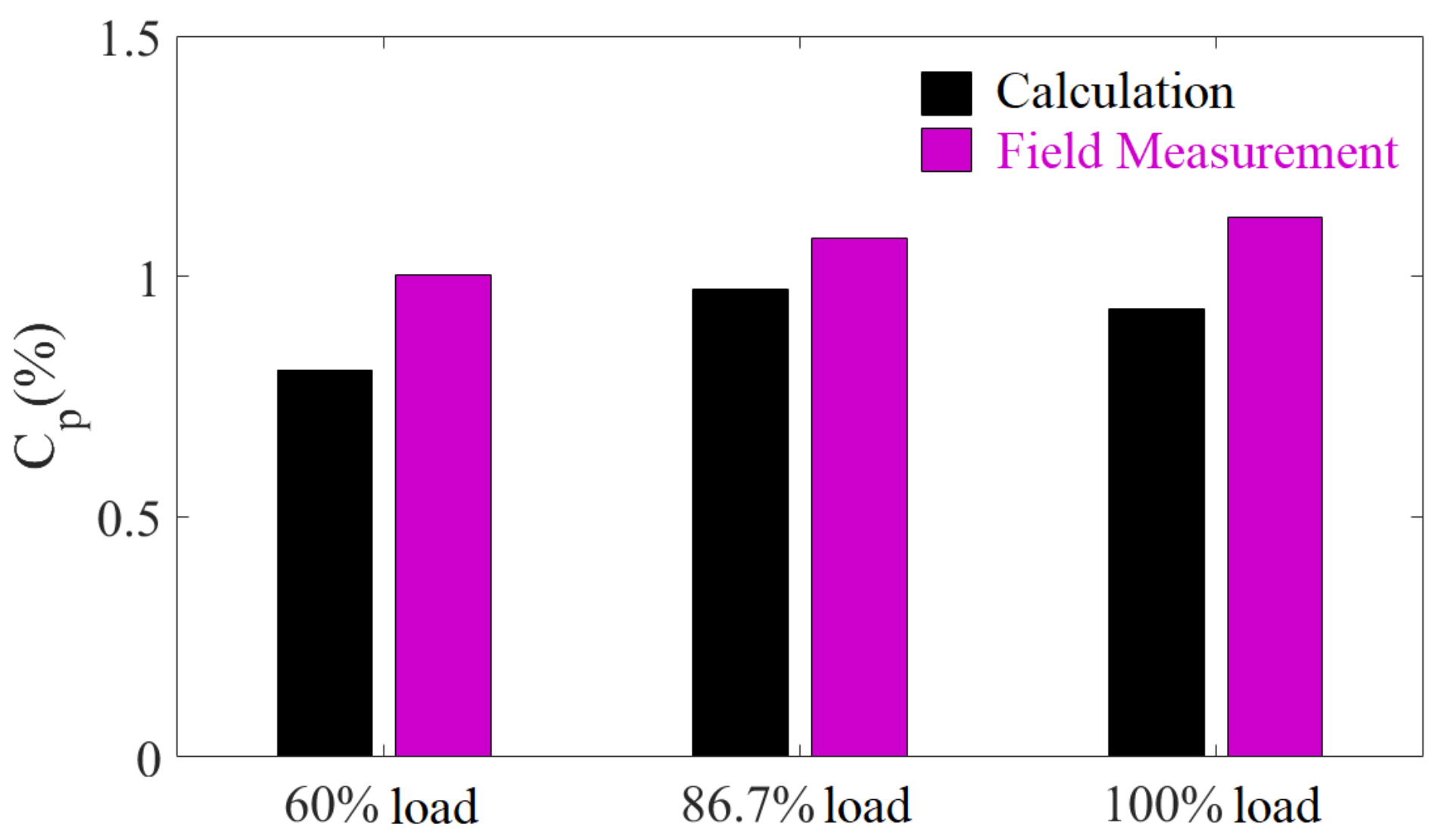

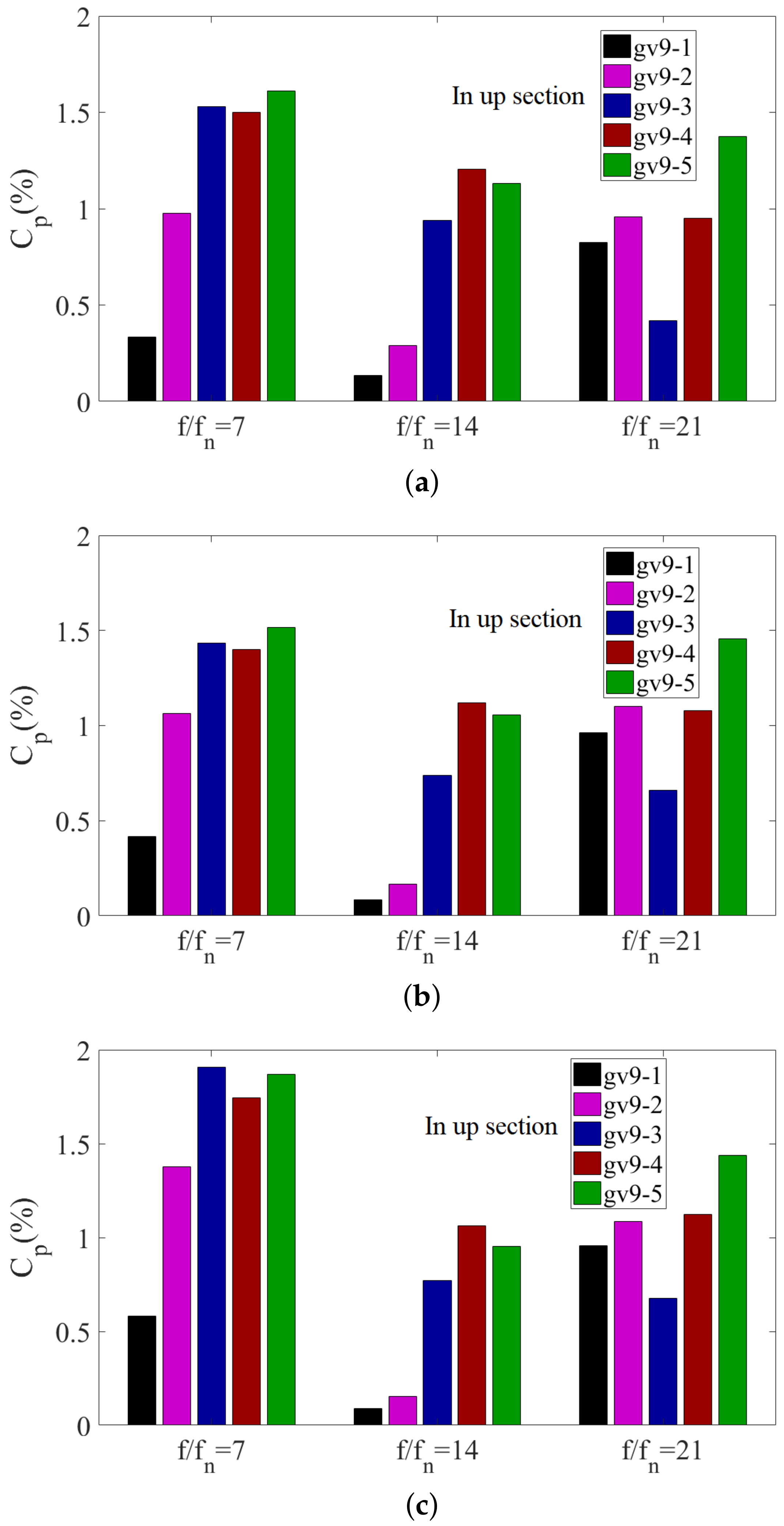


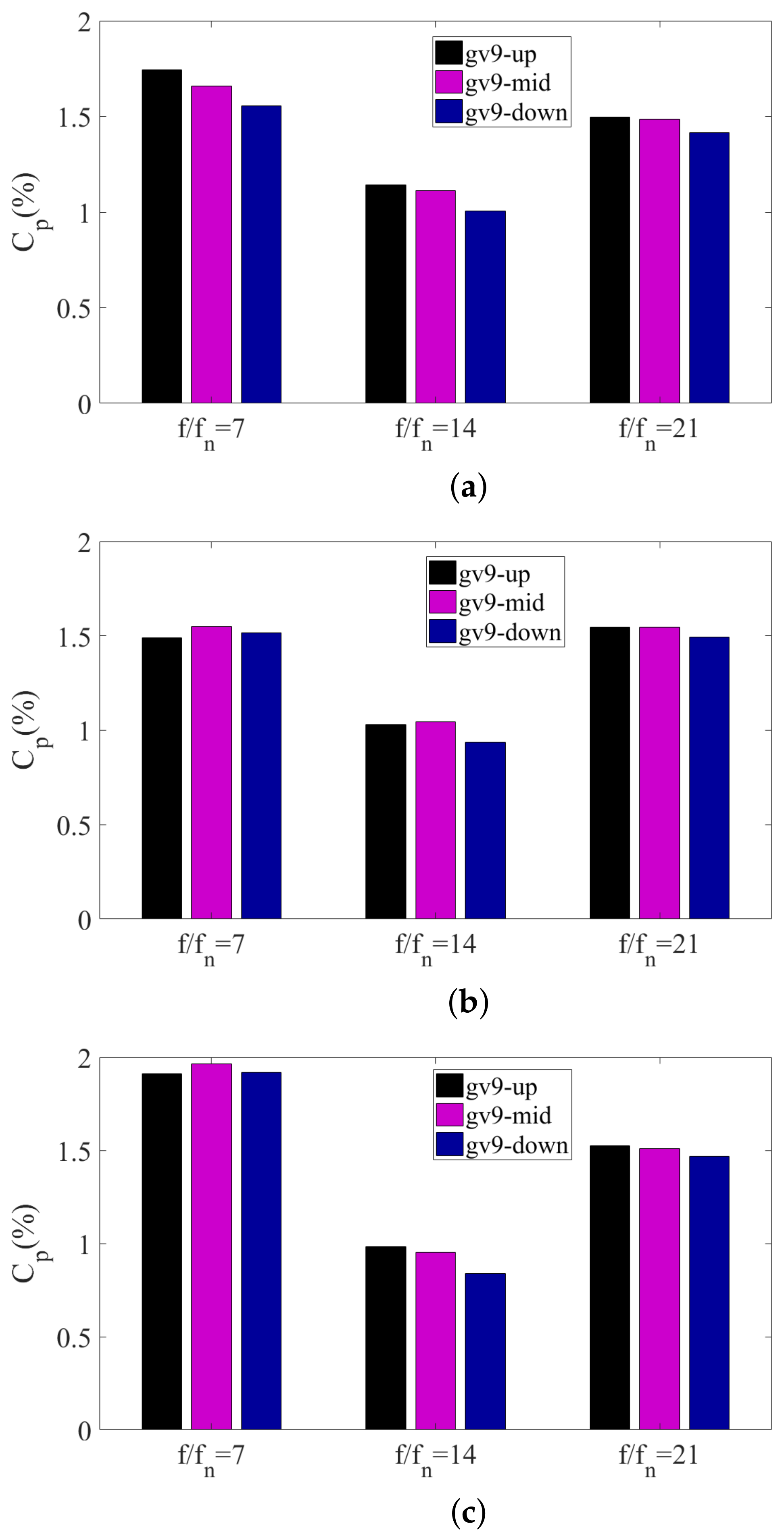
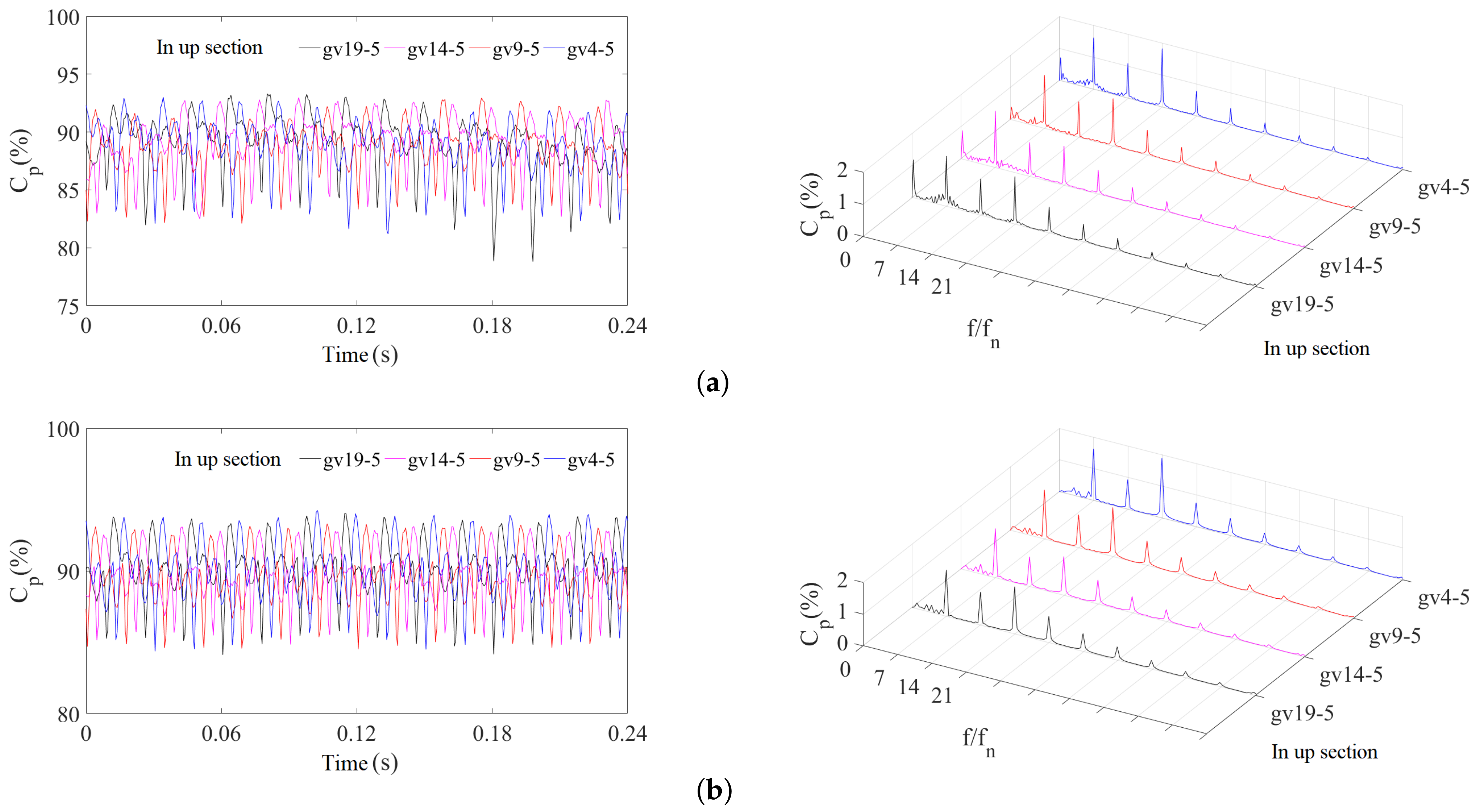


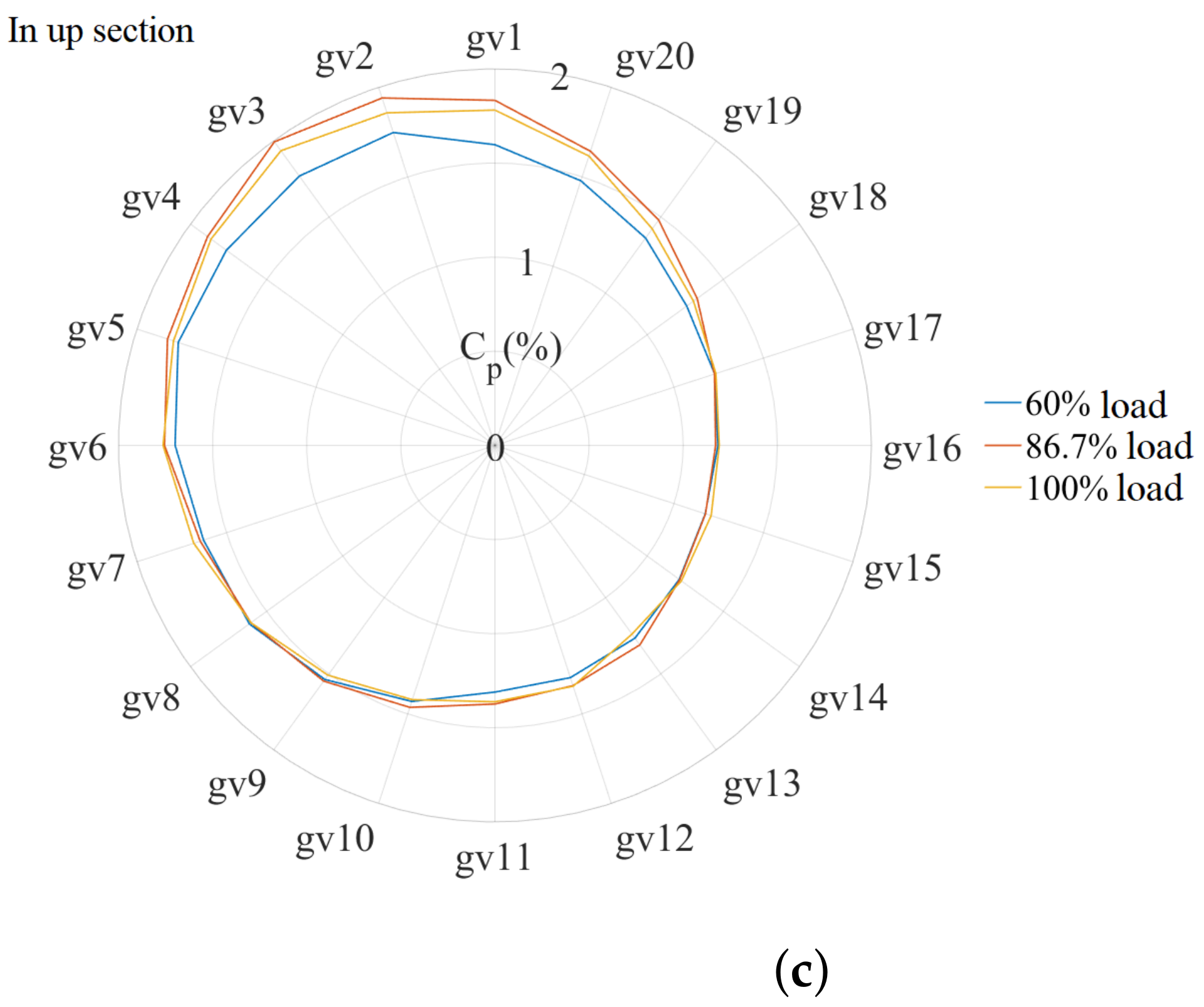
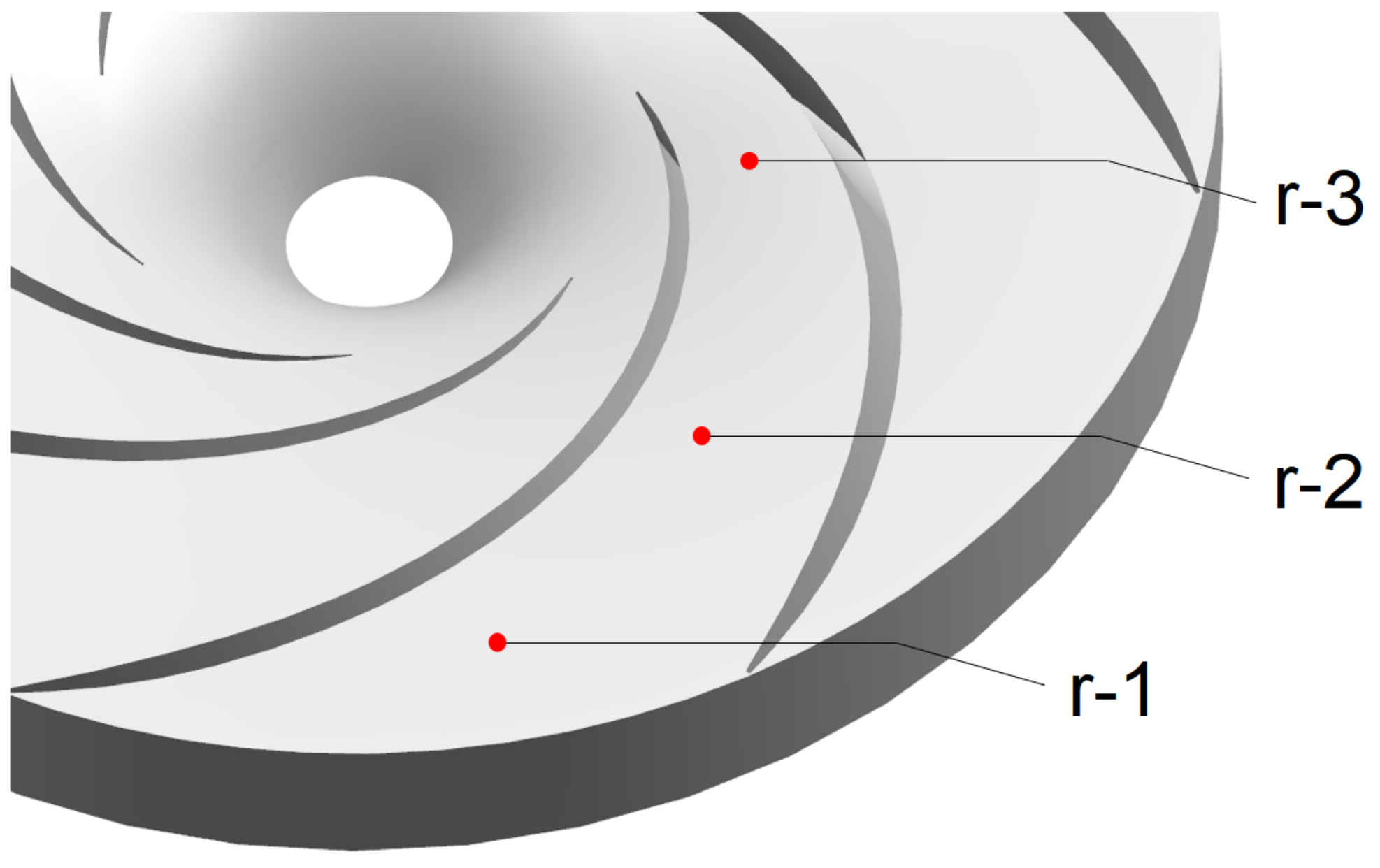
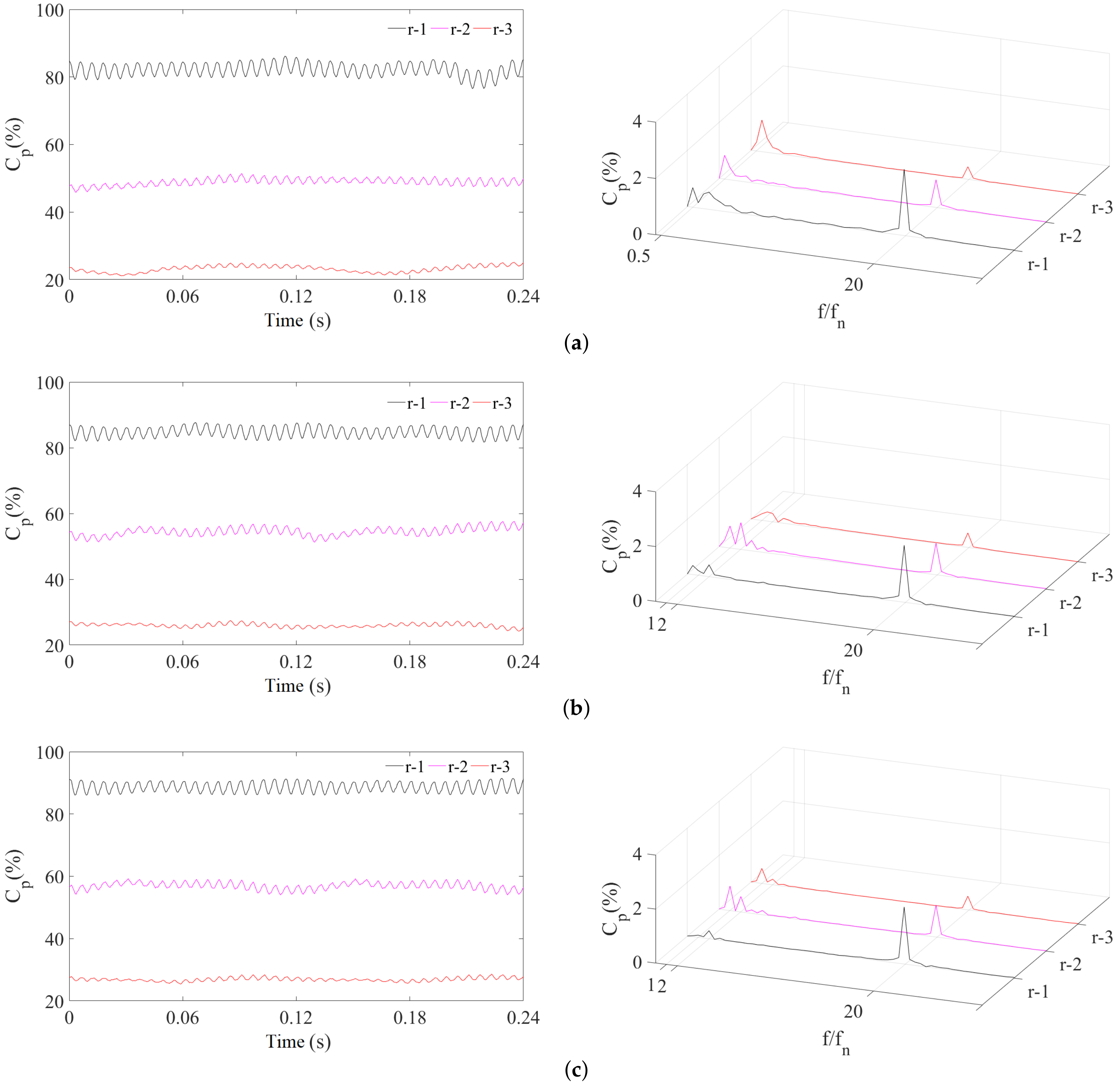
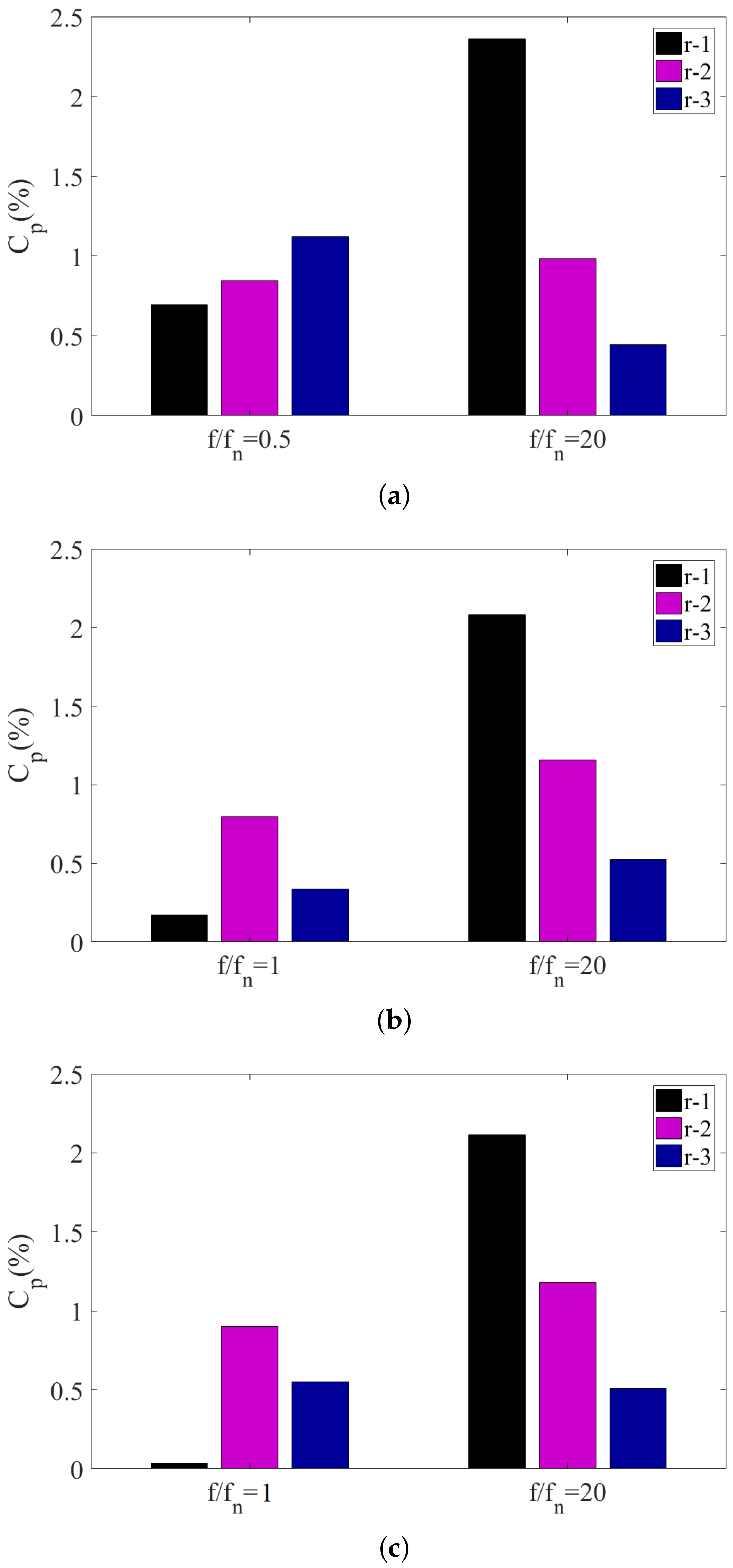
| Parameters | Values |
|---|---|
| Rated power | 300 MW |
| Rated head | 510 m |
| Rated rotational speed | 500 rpm |
| Rated rotational frequency | 8.33 Hz |
| Runner diameter | 3.9 m |
| Dimensionless specific speed | 220 |
| Number of runner blades | 7 |
| Number of guide vanes | 20 |
| Number of stay vanes | 20 |
| Location | Instrument | Model | Range | Accuracy Class |
|---|---|---|---|---|
| Vaneless space | Pressure transducer | MPM480 | 10 MPa | 0.2 |
| Load Conditions | Measured /% | Calculated /% | Error (%) |
|---|---|---|---|
| 60% load | 0.805 | 1.002 | 19.7 |
| 86.7% load | 0.974 | 1.080 | 9.8 |
| 100% load | 0.933 | 1.123 | 16.9 |
Publisher’s Note: MDPI stays neutral with regard to jurisdictional claims in published maps and institutional affiliations. |
© 2022 by the authors. Licensee MDPI, Basel, Switzerland. This article is an open access article distributed under the terms and conditions of the Creative Commons Attribution (CC BY) license (https://creativecommons.org/licenses/by/4.0/).
Share and Cite
Yang, H.; He, Q.; Huang, X.; Yang, M.; Bi, H.; Wang, Z. Experimental and Numerical Investigation of Rotor–Stator Interaction in a Large Prototype Pump–Turbine in Turbine Mode. Energies 2022, 15, 5523. https://doi.org/10.3390/en15155523
Yang H, He Q, Huang X, Yang M, Bi H, Wang Z. Experimental and Numerical Investigation of Rotor–Stator Interaction in a Large Prototype Pump–Turbine in Turbine Mode. Energies. 2022; 15(15):5523. https://doi.org/10.3390/en15155523
Chicago/Turabian StyleYang, Haixia, Qilian He, Xingxing Huang, Mengqi Yang, Huili Bi, and Zhengwei Wang. 2022. "Experimental and Numerical Investigation of Rotor–Stator Interaction in a Large Prototype Pump–Turbine in Turbine Mode" Energies 15, no. 15: 5523. https://doi.org/10.3390/en15155523
APA StyleYang, H., He, Q., Huang, X., Yang, M., Bi, H., & Wang, Z. (2022). Experimental and Numerical Investigation of Rotor–Stator Interaction in a Large Prototype Pump–Turbine in Turbine Mode. Energies, 15(15), 5523. https://doi.org/10.3390/en15155523








